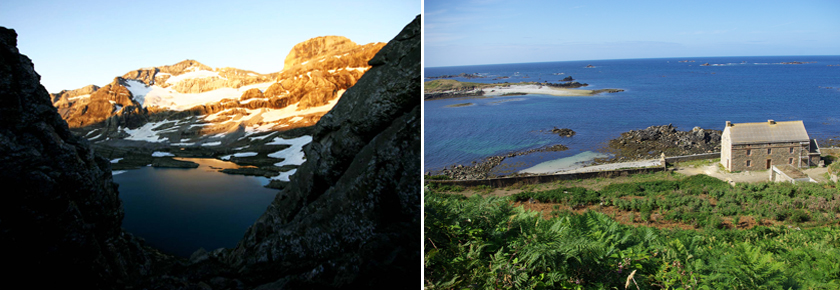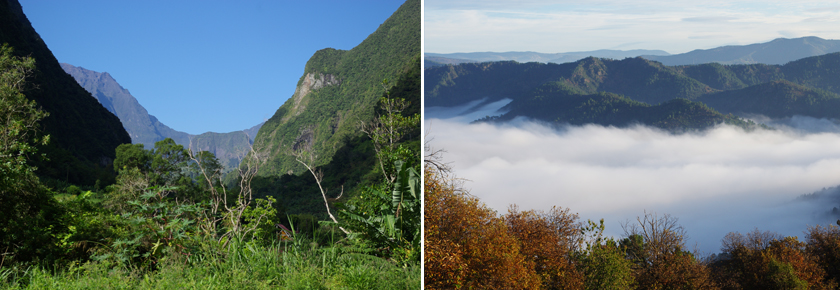
According to the International Union for Conservation of Nature (IUCN), a protected area is "a clearly defined geographical space, recognized, dedicated and managed, through legal or other effective means, to achieve the long-term conservation of nature with associated ecosystem services and cultural values."
The designation of protected natural areas is a major component of strategies to protect and manage the natural heritage. As such, there are in France various protection tools which diversity reflects the multiplicity of stakeholders, objectives and management types.

Parc national des Pyrénées © P.Rouveyrol & Réserve des Sept Îles © P.Gourdain
The development and regular updating of a national database of protected areas prove to be indispensable to address national, Community and international stakes in terms of monitoring and evaluation of policies for the conservation of nature. Such database should have a reliable, timely, consistent and standardized information and provide a national benchmark for the different stakeholders, from local to European level.
Since the early 90s, the Natural Heritage Service of the Muséum national d'Histoire naturelle (MNHN-SPN) is, at the request of the Ministry in charge of Ecology, responsible for the management of knowledge on protected areas. The MNHN-SPN thus implements (develops and manages) the "Database of Protected Areas" and answers for its national consistency.
Ultimately, this baseline aims to integrate all types of areas for which data can be mobilized, and to provide protection or management of natural heritage (regulatory, contractual, or property protection, or designation under European or international conventions and commitments). Natura 2000 sites are not included in the national database because they are subject to a specific program managed by the MNHN.
Lists of protections currently included in the database:

Parc national de la Réunion © P.Gourdain & Parc national des Cévennes © P.Gourdain
| Protection categories | Protection type |
|---|---|
| Regulatory protections | Biotope protection Decree |
| Natural habitats protection Orders | |
| Decree lists of sites of geological interest | |
| Geotope protection order | |
| Wilderness National Park | |
| National park, heart area | |
| Managed biological reserve | |
| Wilderness biological reserve | |
| National hunting and wildlife reserves | |
| National nature reserve | |
| Regional nature reserve | |
| Corsican nature reserves | |
| Protective perimeters of nature reserve | |
| Enhanced or integral protection zones of nature reserves | |
| Contractual protections | National Park, partnership zone |
| Regional nature park | |
| Marine nature park | |
| Protections through land management | Land owned by the Conservatoire du Littoral |
| Land purchased (or similar) by a Conservatory of Natural Spaces | |
| Sensitive natural areas | |
| Protections under European and international conventions or commitments | Wetland protected by the Ramsar Convention |
| Biosphere Reserve, central area | |
| Biosphere Reserve, transition area | |
| Biosphere Reserve, buffer area | |
| World heritage site (natural criteria) | |
| UNESCO Global Geopark | |
| Marine protected area of the OSPAR Convention (Atlantic Northeast) | |
| Protected area of the Cartagena Convention (Caribbean) | |
| Specially Protected Area of Mediterranean interest of the Barcelona Convention | |
| Antarctic Specially Protected Areas | |
| Protected areas specific to New Caledonia | North Province |
| Integral wilderness area | |
| Wilderness area | |
| Provincial parks | |
| Nature reserves | |
| Areas of protection and enhancement of natural and cultural heritage | |
| Sustainable resource management areas | |
South Province |
|
| Integral wilderness area | |
| Nature reserves | |
| Sustainable resource management areas | |
| Provincial parks | |
| Protected areas specific to French Polynesia | Integral wilderness area / Wilderness zone |
| Territorial Park | |
| Natural monument | |
| Habitat or species management area | |
| Protected landscape | |
| Managed marine or terrestrial area |
It contains descriptive data (site name, date of creation, renewal or modification, municipality(ies), region(s), area, official text, fauna-flora-habitat data ...) and geographical information (GIS layers) on protected areas of metropolitan France and overseas, terrestrial and marine.
This database is the reference of the Natural Heritage Inventory Information System (SINP) and the National Observatory of Biodiversity (ONV) in terms of knowledge on protected areas.
Other protected areas are deployed in the territory but are not, for the moment, integrated into the INPN due to the lack of a consolidated national layer. This is the case of Sensitive Natural Areas (SNA), tools for land control in the Departments or Classified Sites (CS), regulatory tools for the protection of natural monuments and sites whose conservation or preservation is of general interest from an artistic, historical, scientific, legendary or picturesque point of view.
Website of the Assembly of French Departments
SNA presentation leaflet (ADF-2015)
Presentation of the Ministry of the Environment's site policy
An assembly of data producers and / or data managers, partnered with the MNHN, help to feed and update the national baseline. These are mainly decentralized services and operators of the State.
These partners regularly send their data on protected areas to the MNHN, following the procedures of update defined in the memorandum. The latter performs various methodological and technical controls on these data, completes the input, and centralizes it in the national database of protected areas.
Extracts from this national database regularly document the European Common Database on Designated Areas (CDDA) of the European Environment Agency, enabling the update of the global World Database on Protected Areas (WDPA) of the World Conservation Monitoring Centre (WCMC) of the United Nations Environment Programme and IUCN.
GIS layers of the INPN also document the geographical information broadcast applications on the web: Geoportal of IGN, Carmen and OpenStreetMap.
Data synthesis for protected areas in France